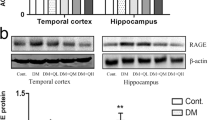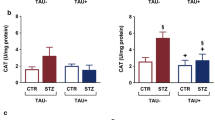Abstract
Redox imbalances and altered signaling processes in the brain are characteristic features of diabetic complications. Hence, the present study therefore sought to evaluate the effect of gallic acid (GA) on disturbed redox systems and activity of neurotransmission signaling dependent enzymes such as sodium pump, purinergic enzymes and acetylcholinesterase in diabetic animal models. We observed that GA markedly improves the antioxidant status of diabetic animals. Furthermore, the diminution of the activity of Na+/K+-ATPase and increased activities of acetylcholinesterase and the purinergic enzymes associated with diabetes progression were reversed to normalcy with the administration of GA in diabetic animals. Hence, we conclude that GA is a potential candidate in the management of neuronal dysfunction that often accompanied complications associated with diabetic hyperglycemia.




Similar content being viewed by others
References
Bloomgarden ZT (2007) Diabetic neuropathy. Diabetes Care 30:1027–1032
Mijnhout GS, Scheltens P, Diamant M, Biessels GJ, Wessels AM, Simsek S, Snoek FJ, Heine RJ (2006) Diabetic encephalopathy: a concept in need of a definition. Diabetologia 49:1447–1448
Sima AAF, Kamiya H, Lia ZG (2004) Insulin, C-peptide, hyperglycemia, and central nervous system complications in diabetes. Eur J Pharmacol 490:187–197
Reijmer YD, van den Berg E, Ruis C, Kappelle LJ, Biessels GJ (2010) Cognitive dysfunction in patients with type 2 diabetes. Diabetes Metab Res Rev 26:507–519
Navaratna D, Guo SZ, Hayakawa K, Wang X, Gerhardinger C, Lo EH (2011) Decreased cerebrovascular brain-derived neurotrophic factor-mediated neuroprotection in the diabetic brain. Diabetes 60:1789–1796
Drel VR, Sybirna N (2010) Protective effects of polyphenolics in red wine on diabetes associated oxidative/nitrative stress in streptozotocin-diabetic rats. Cell Biol Int 34:1147–1153
Arvanitakis Z, Wilson RS, Bienias JL, Evans DA, Bennett DA (2004) Diabetes mellitus and risk of Alzheimer disease and decline in cognitive function. Arch Neurol 61:661–666
Whaley-Connell A, McCullough PA, Sowers JR (2011) The role of oxidative stress in the metabolic syndrome. Rev Cardiovasc Med 12:21–29
Baynes JW (1991) Role of oxidative stress in development of complications of diabetes mellitus. Diabetes 40:405–412
Potter JD (1997) Cancer prevention: epidemiology and experiment. Cancer Lett 114:7–9
Prince PSM, Kumar MR, Selvakumari CJ (2011) Effects of gallic acid on brain lipid peroxide and lipid metabolism in streptozotocin-induced diabetic Wistar rats. J Biochem Mol Toxicol 25(2):101–107
Punithavathi VR, Prince PSM, Kumar R, Selvakumari J (2011) Antihyperglycaemic, antilipid peroxidative and antioxidant effects of gallic acid on streptozotocin induced diabetic Wistar rats. Eur J Pharmacol 650:465–471
Latha RCR, Daisy P (2011) Insulin-secretagogue, antihyperlipidemic and other protective effects of gallic acid isolated from Terminalia bellerica Roxb. in streptozotocin-induced diabetic rats. Chem Biol Interact 189:112–118
Punithavathi VR, Prince PSM, Kumar MR, Selvakumari CJ (2011) Protective effects of gallic acid on hepatic lipid peroxide metabolism, glycoprotein components and lipids in streptozotocin-induced type ii diabetic Wistar rats. J Biochem Mol Toxicol 25(2):68–76
Barbosa NBV, Rocha JBT, Wondracek DC, Perottoni J, Zeni G, Nogueira CW (2006) Diphenyl diselenide reduces temporarily hyperglycemia: possible relationship with oxidative stress. Chem Biol Interact 163:230–238
Kade IJ, Borges VC, Savegnago L, Ibukun EO, Zeni G, Nogueira CW, Rocha JBT (2009) Effect of oral administration of diphenyl diselenide on antioxidant status, and activity of delta aminolevulinic acid dehydratase and isoforms of lactate dehydrogenase, in streptozotocin-induced diabetic rats. Cell Biol Toxicol 25:415–424
Kade IJ, Nogueira CW, Rocha JBT (2009) Diphenyl diselenide and streptozotocin did not alter cerebral glutamatergic and cholinergic systems but modulate antioxidant status and sodium pump in diabetic rats. Brain Res 1284:202–211
Szkudelski T (2001) The mechanism of alloxan and streptozotocin action in β-cells of the rat pancreas. Physiol Res 50:536–546
Lowry OH, Rosenbrough NJ, Farr AL, Randall RJ (1951) Protein measurement with folin-phenol reagent. J Biol Chem 193:265–275
Jacques-Silva MC, Nogueira CW, Broch LC, Flores EM, Rocha JBT (2001) Diphenyl diselenide and ascorbic acid changes deposition of selenium and ascorbic acid in liver and brain of mice. Pharmacol Toxicol 88:119–127
Ellman GL (1959) Tissue sulfhydryl groups. Arch Biochem Biophys 82:70–77
Ohkawa H, Ohishi N, Yagi K (1979) Assay for lipid peroxides in animal tissues by thiobarbituric acid reaction. Anal Biochem 95:351–358
Omololu PA, Rocha JBT, Kade IJ (2011) Attachment of rhamnosyl glucoside on quercetin confers potent iron-chelating ability on its antioxidant properties. Exp Toxicol Pathol 63:249–255
Pulido R, Bravo L, Saura-Calixto F (2000) Antioxidant activity of dietary polyphenols as determined by a modified ferric reducing/antioxidant power assay. J Agri Food Chem 48:3396–3402
Puntel RL, Nogueira CW, Rocha JBT (2005) Krebs cycle intermediates modulate thiobarbituric acid reactive species (TBARS) production in rat brain in vitro. Neurochem Res 30:225–235
Aebi H (1984) Catalase in vitro. Methods Enzymol 105:121–126
Habig WH, Pabst MJ, Jakoby WB (1974) Glutathione S-transferases the first enzymatic step in mercapturic acid formation. J Biol Chem 249:7130–7139
Sassa S (1982) Delta-aminolevulinic acid dehydratase assay. Enzyme 28:133–145
Battastini AMO, Rocha JBT, Barcellos CK, Dias RD, Sarkis JJF (1991) Characterization of an NTPDase (EC 3.6.1.5) in synaptosomes from cerebral cortex of adult rats. Neurochem Res 16:1303–1310
Heymann D, Reddington M, Kreutzberg GW (1984) Subcellular localization of 50-nucleotidase in rat brain. J Neurochem 43:971–978
Kade J, Paixão MW, Rodrigues OED, Barbosa NBV, Braga AL, Ávila DS, Nogueira CW, Rocha JBT (2008) Comparative studies on dicholesteroyl diselenide and diphenyl diselenide as antioxidant agents and their effect on the activities of Na+/K+-ATPase and ð-aminolevulinic acid dehydratase in the rat brain. Neurochem Res 33:167–178
Fiske CH, Subbarow YJ (1925) The colorimetric determination of phosphorus. J Biol Chem 66:375–381
Ellman GL, Courtney KD, Anders VJR, Featherstone RM (1961) A new rapid colorimetric determination of acetylcholinesterase activity. Biochem Pharmacol 7:88–95
Wohaieb SA, Godin DV (1987) Alterations in free radical tissue-defense mechanisms in streptozocin-induced diabetes in rat: effects of insulin treatment. Diabetes 36:1014–1018
Ozkaya YG, Agar A, Yargicoglu P, Hacioglu G, Bilmen-Sarikcioglu S, Ozen I et al (2002) The effect of exercise on brain antioxidant status of diabetic rats. Diabetes Metab 28:377–384
Hayes JD, Pulford DJ (1995) The glutathione S-transferase supergene family: regulation of GST and the contribution of the isoenzymes to cancer chemoprevention and drug resistance. Crit Rev Biochem Mol Biol 30:445–600
Gyamfi AM, Ohtani II, Shinno E, Aniya Y (2004) Inhibition of glutathione S transferases by thonningianin A, isolated from the African medicinal herb, Thonningia sanguinea, in vitro. Food Chem Toxicol 42:1401–1408
Jaffe EK (1995) Porphobilinogen synthase, the first source of heme’s asymmetry. J Bioenerg Biomembr 27:169–179
Barbosa NBV, Rocha JBT, Zeni G, Emanuelli T, Beque MC, Braga AL (1998) Effect of organic selenium on δ-aminolevulinate dehydratase from liver, kidney, and brain of adult rats. Toxicol Appl Pharmacol 149:243–253
Vieira VLP, Rocha JBT, Schetinger MRC, Morsch VM, Rodrigues SR, Tuerlinckz SM, Bohrer D, Nascimerto PC (2000) Effect of aluminum on d-aminolevulinic acid dehydratase from mouse blood. Toxicol Lett 117:45–52
Rocha JBT, Saraiva RA, Garcia SC, Gravina FS, Nogueira CW (2011) Aminolevulinate dehydratase (δ-ALA-D) as marker protein of intoxication with metals and other pro-oxidant situations. Tox Res 1:85–102
Farina M, Barbosa NBV, Nogueira CW, Folmer V, Andrade LH, Zeni G, Bolzan RC, Braga AL, Rocha JBT (2002) Reaction of diphenyl diselenide with hydrogen peroxide and inhibition of delta-aminolevulinate dehydratase from rat liver and cucumber leaves. Braz J Med Biol Res 35:623–631
Sassa S, Fujita H, Kappas A (1989) Genetic and chemical influences on heme biosynthesis. In: Kotyk A, Skoda J, Paces V, Kostka V (eds) Highlights of Modern Biochemistry, vol 1. VSP, Utrecht, pp 329–338
Bechara EJH, Medeiros MHG, Monteiro HP, Hermes-Lima M, Pereira B, Demasi M, Acosta CA, Abdalla DSP, Onuki J, Wendel CAM, Di Mascio P (1993) A free radical hypothesis of lead poisoning and inborn porphyries associated with 5-aminolevulinic acid overload. Quim Nova 16:385–392
Emanuelli T, Rocha JBT, Pereira ME, Nascimento PN, Souza DOG, Beber FA (1998) δ-Aminolevulinate dehydratase inhibition by 2,3-dimercaptopropanol is mediated by chelation of zinc from a site involved in maintaining cysteinyl residues in a reduced state. Pharmacol Toxicol 83:95–103
Rocha JBT, Pereira ME, Emanuelli T, Christofari RS, Souza DO (1995) Effect of treatment with mercuric chloride and lead acetate during the second stage of rapid post-natal brain growth on ALA-D activity in brain, liver and blood of suckling rats. Toxicology 100:27–37
Rocha JBT, Rocha LK, Emanuelli T, Pereira ME (2001) Effect of mercuric chloride and lead acetate treatment during the second stage of rapid postnatal brain growth on the behavioral response to chlorpromazine and on delta-ALA-D activity in weaning rats. Toxicol Lett 125:143–150
Valentovic MA, Ball JG (1998) 2-Aminophenol and 4-aminophenol toxicity in renal slices from Sprague-Dawley and Fischer 344 rats. J Toxicol Environ Health A 55:225–240
Lash LH, Tokarz JJ, Pegouske DM (1995) Susceptibility of primary cultures of proximal tubular and distal tubular cells from rat kidney to chemically induced toxicity. Toxicology 103:85–103
Kaplan A, Szabo LL, Opheim KE (1988) Clinical Chemistry, 3rd edn. Lea and Febiger, Philadelphia, p 135
Chu TM (1987) Biochemical Markers for Human Cancer. Curr Topics Pathol 77:19–45
Glynn IM (1985) The Na+, K+-transporting adenosine triphosphatase In: Martonosi AN (ed) The enzymes of biological membranes, vol 3, 2nd edn. Plenum, New York, pp 35–114
Greene DA, Lattimer SA, Sima AAF (1987) Sorbitol, phosphoinositides and sodium-potassium ATPase in the pathogenesis of diabetic complications. N Engl J Med 316:599–606
Winegrad AI (1987) Does a common mechanism induce the diverse complication of diabetes? Diabetes 36:396–406
Ver A, Csermely P, Banyasz T, Kovacs T, Somogyi J (1995) Alterations in the properties and isoform ratios of brain Na+/K+-ATPase in streptozotocin diabetic rats. Biochim Biophys Acta 1237:143–150
Temel HE, Akyuz F (2007) The effects of captopril and losartan on erythrocyte membrane Na+/K+-ATPase activity in experimental diabetes mellitus. J Enzyme Inhib Med Chem 22:213–217
Lunkes GI, Lunkes DS, Morsch VM, Mazzanti CM, Morsch A, Miron V, Schetinger M (2004) NTPDase and 5′-nucleotidase in rats alloxan-induced diabetes. Diabetes Res Clin Pract 65:1–6
Mazzanti CM, Spanevello RM, Pereira LB, Gonc JF, Alves R, Kaizer M, Corrêa M, Ahmed A, Mazzanti R, Festugatto DL, Gracia D, Morsch VM, Schetinger MRC (2006) Acetylcholinesterase activity in rats experimentally demyelinated with ethidium bromide and treated with interferon beta. Neurochem Res 31:1027–1032
Schetinger MRC, Morsch VM, Bonan C, Wyse A (2008) NTPDase and 5′-nucleotidase activities in physiological and disease conditions: new perspectives for human health. Biofactors 31:77–98
Spanevello RMM, Mazzanti CM, Kaizer R, Zanin R, Cargnelutti D, Hannel L, Côrrea M, Mazzanti A, Festugatto RD, Gracia D, Schetinger MRC, Morsch V (2006) NTPDase and 5′-nucleotidase activities in synaptosomes from the cerebral cortex of rats experimentally demyelinated with ethidium bromide and treated with interferon. Neurochem Res 31:455–462
Kuhad A, Sharma S, Chopra K (2008) Lycopene attenuates thermal hyperalgesia in a diabetic mouse model of neuropathic pain. Eur J Pharmacol 12:624–632
Sanchez-Chavez G, Salceda R (2000) Effect of streptozotocin-induced diabetes on activities of cholinesterases in the rat retina. IUBMB Life 49:283–287
Appleyard ME (1992) Secreted acetylcholinesterase: non-classical aspects of a classical enzyme. Trends Neurosci 15:485–490
Zimmermann H (2008) ATP and acetylcholine, equal brethren. Neurochem Int 52:634–648
Lendvai B, Vizi ES (2008) Nonsynaptic chemical transmission through nicotinic acetylcholine receptors. Physiol Rev 88:333–349
Mesulam MM, Guillozet A, Shaw P, Levey A, Duysen EG, Lockridge O (2002) Acetylcholinesterase knockouts establish central cholinergic pathways and can use butyrylcholinesterase to hydrolyze acetylcholine. Neuroscience 110:627–639
Biessels GJ, Deary IJ, Ryan CM (2008) Cognition and diabetes: a lifespan perspective. Lancet Neurol 7:184–190
Kuhad A, Chopra K (2007) Curcumin attenuates diabetic encephalopathy in rats: behavioral and biochemical evidences. Eur J Pharmacol 576:34–42
Acknowledgments
This study was supported by grants from CAPES, FINEP, FAPERGS, PRONEX and CNPq. The authors are also thankful to the FINEP research grant ‘Rede Instituto Brasileiro de Neurociencia (IBN-Net)’ #01.06.0842-00 and the INCT for Excitotoxicity and Neuroprotection-CNPq. In addition, the work is also supported by CNPq-ProAfrica grant awarded to IJK and JBTR.
Author information
Authors and Affiliations
Corresponding author
Rights and permissions
About this article
Cite this article
Kade, I.J., Rocha, J.B.T. Gallic Acid Modulates Cerebral Oxidative Stress Conditions and Activities of Enzyme-Dependent Signaling Systems in Streptozotocin-Treated Rats. Neurochem Res 38, 761–771 (2013). https://doi.org/10.1007/s11064-013-0975-6
Received:
Revised:
Accepted:
Published:
Issue Date:
DOI: https://doi.org/10.1007/s11064-013-0975-6




